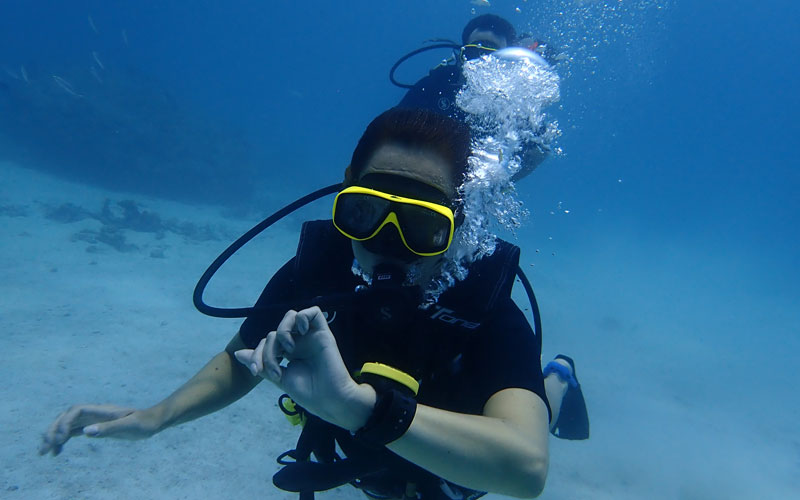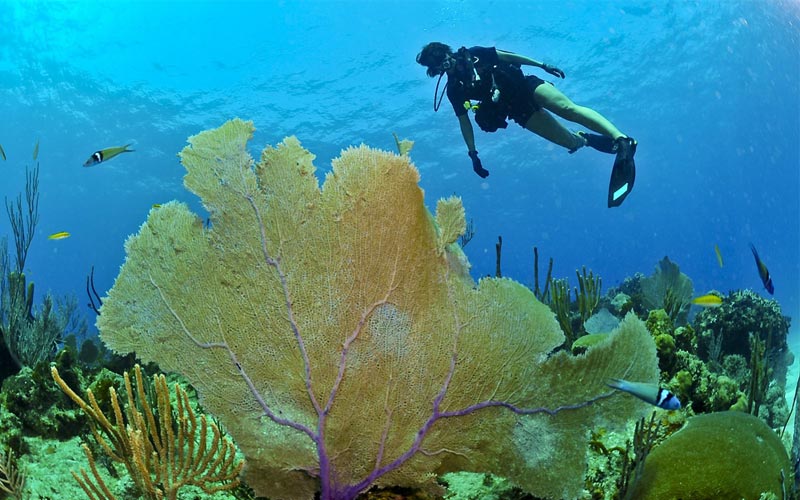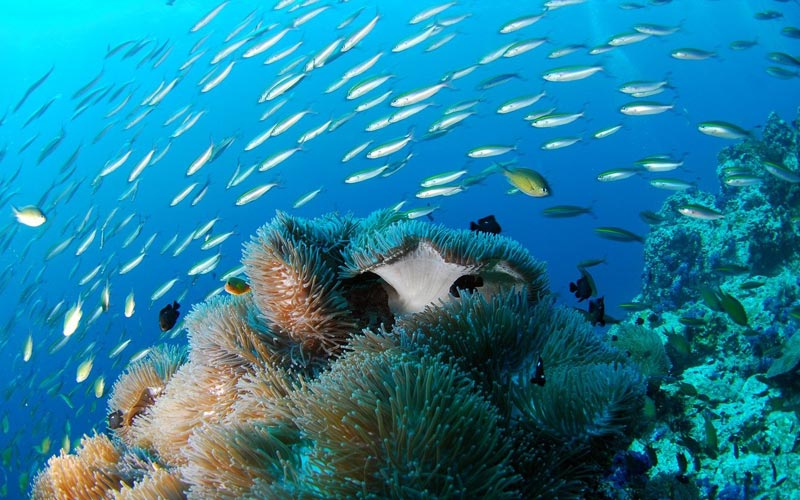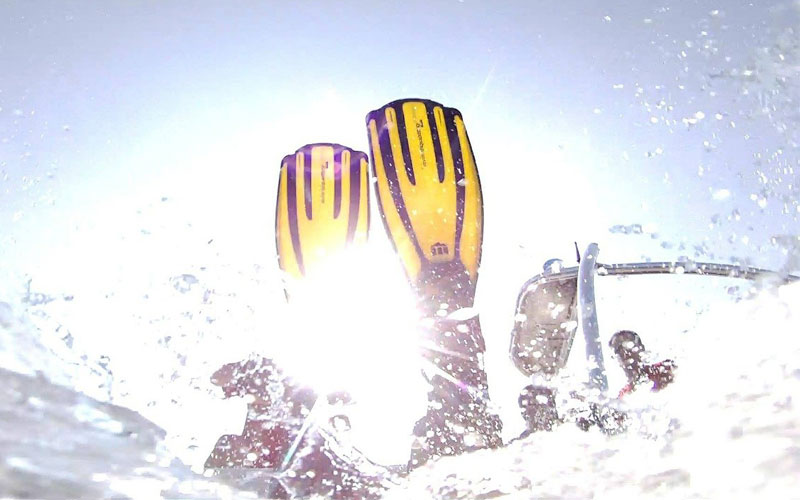DIVING
IN ZANZIBAR
A GUIDE FOR DIVING IN ZANZIBAR
Underrated as it must have been, scuba diving in Zanzibar is a rewarding experience and an awesome destination for adventures who want to discover a new dive destination. It offers a wealth of tropical reef diving, unexpected encounter with larger oceanic species along the Indian Ocean as well as deep exploration to forgotten shipwrecks. Diving is also possible all year round so make sure you tick the box for this trip on your itinerary.
Here are some of the common FAQs you need answers to:
Source: https://www.climbkilimanjaroguide.com/diving-zanzibar/
July and August are considered the best months for diving in Zanzibar, but the high season typically spans July to September and December to January, when the weather is at its hottest and most humid.
However, unlike other diving destinations around the world, a high season doesn’t always mean lots of divers. Often even during the peak season you’ll be able to find an almost empty diving spot. This is especially true on Pemba Island.
In short, diving is possible year-round, although the main dive season is from November through to March.
The diving conditions in Zanzibar are great whether you’re a scuba diving beginner or a seasoned advance diver. Waters are incredibly clear, corals are in wonderful condition and the water temperature in this part of the Indian Ocean is around 27-29 celsius between November and May.
With incredible diving conditions and high visibility all year round, the archipelago is a popular destination for scuba diving, particularly the Mnemba Atoll and Msali Island, which attracts experience divers along with those seeking novice exploration.
Travelers can choose from thirty diving sites around Zanzibar that offer waters of consistently warm temperatures of 27 celsius and visibility of up yo 60m making it perfect for diving amongst large fish such as whale sharks, tuna, barracudas and wahoo.
The strip of water between Ugunja and Pemba attracts many divers visiting Zanzibat with incredible marine biodiversity and clear condition; it hosts some of the best diving sited in East Africa.
Most diving courses and day trips are run by reputable companies but be sure that your instructors and guides are PADI certified before booking anything.
There are so many amazing diving spots that it’s hard to reduce them to a brief list. So instead, I’ve picked a few sites that stood out from our experience and from fellow diving reviews. The best dive spots are found in the northern tip of Zanzibar, including Mnemba Atoll, Nungwi Reefs, Tumbatu Island and Leven Bank.
A few years back, the Nungwi Reefs site was voted one of the top scuba diving locations in the world. It’s located north of Zanzibar city at the Northend End of the Island. There are over 100 species of hard corals here including staghorn, elkhorn, brain and table corals.
Here’s a summary of the top dive spots.
MNEMBA ATOLL FOR WHALE SHARKS, MANTA RAYS AND THOUSANDS OF TROPICAL FISH
Mnemba Island offers many diving sites for all levels from deep walls to honeycomb, Staghorn and Mushroom coral gardens. This conversation area has an abundance of small brightly colored schools of aquatic life to large whale sharks and gentle manta rays.
The shallower reefs like Wattabomi are fantastic for novice divers who can catch sight of Blue Spotted Rays, Moorish Idols and schools of Angelfish among many others. West Gardens is also great for a relaxing easy drive of 12 metres.
For a glimpse of Parrotfish and Green Turtles head to Aquarium, with a slight current and depths of up to 20 meters this site is better suited to more experience divers. For deep drift diving, the wall offers fantastic views of the vast 30 to 50 meter drop teeming with Bluefin Trevally and schools of Rainbow Runner.
Many of the Zanzibar resorts close to Mnemba Island offer diving day trips to the Island as well as most of the diving resorts in Nungwi and Kendwa, if you feel like a deserted island getaway with a touch of luxury you can always book into the Mnemba Island Lodge.
DIVE IN MISALI TO SEE 42 CORALS
Misali Island is considered one of the best diving areas in East Africa and possibly in the world. This stunning part of the Pemba Channel Conservation Area is situated just west of Pemba Island.
The untouched corals surrounding the entire island give life to an extensive array of marine creatures. As a protected area, divers are encouraged not to touch the corals so as to conserve the natural ecosystems which house approximately 42 different corals and more than 400 species of aquatic life.
Divers can arrange trips to the island through their travel agencies and hotels, or take a boat out from Wesha but Fundu Lodge is an excellent choice for diving enthusiasts and as a 5 star rated PADI resorts offers everything from half day introductions to advanced open water diving as well as excursions to most of the best diving sited around Pemba Island.
FOR VIBRANT CORALS AND SHALLOW REEFS, HEAD TO MAFIA ISLAND
Tanzania’s first marine park can be located around Mafia Island and offers around 20 different diving sites. Kinasi wall hosts an array of hard and soft corals teeming with aquatic life.
Explore passages and caves located at the Jina wall and Dindini diving site or marvel at the incredible coral formations at the Tutia reef. If you’re diving between July and October be sure to look out for the Humpback whales.
For a post wall dive explore the colorful Coral Gardens behind the Kinasi wall where dense coral outcrops host vibrant fish, turtles and seahorses.
GO SHIPWRECK DIVING NEAR STONE TOWN
The shores around Stone Town, harbor as much history as the coral stones that make up the ancient buildings in and around Zanzibar’s Old Town, from Portuguese and British conquerors to fallen sultans and a dark history of slave trading. The wrecks around Stone Town have since created beautiful reefs worth exploring.
Across the ocean floor lies The Great Northern which sank in 1902 and has since transformed into a reef home to geometric morays, lionfish, groupers and glassfish. At a shallow 12m this site is excellent for all levels.
For more advanced divers head to the Royal Navy Lighter site. At a depth of 30m it’s a great site to spot Sweepers, Trevally, Rainbow Runners and Reef sharks.
DRIFT DIVE OFF NJAO ISLAND
An excellent site for drift diving is the Njao Gap located on the Njao island west of Pemba Island.
This beautiful coral reef varies from 5m to 18m in depth and is home to the resident Hawksbill turtle. Divers get gently swept into the Njao Gap with the northern current where they can drift past large Manta Ray, Napoleon Wrasse and Green Turtles while admiring the stunning coral gardens. The reef then gives wat to an extensive deep cliff wall beyond diving depths.
CEMENT WALL SITE AND PAJE CAVES
Divers come to the southeast coast to see three anchors from a ship that lost its cement cargo in the 1930s at what’s now known as the Cement Wall site. Divers also report seeing sharks, napoleon wrasse and turtles here.
Paje Caves are a large and potentially dangerous cave system filled with stalagmites and stalactites. You will also find lots of caves and tunnels to explore. Not a place for a novice on their own.
MNAZI BAY
Mnazi Bay is popular for diving because of its proximity to the shore and variety of soft and hard corals, which attract the big marine life favorites such as sharks, tuna, manta rays and eagle rays.
MAKUTI POINT
Makuti Point is one of the few sites where you can see both soft and hard corals together. You will also get great views of the nearby pinnacles. Makuti Archipelago is one og the smallest groups of islands in the region. They are located east of Zanzibar and consist of four main islands – Makutupi, Matem, Misali and Mik.
UNGUJA ARCHIPELAGO
For pristine white sand beaches and crystal clear waters, try the Unguja Archipelago, which contains over 50 miniature islands, of which some are inhabited, whilst the others are completely devoid of the human race.
Marine Park is found on the southern side of the island is a preserved area with lots of tropical coral formations.
THE TUMBATU ISLANDS
The Tumbatu Islands are a small group of islands, connected by sandbanks. They have great opportunities for drift diving. They offer clear water visibility which makes them excellent for snorkeling too. The abundance of sea fans and sponges give shelter to all kinds of animals.
Beware of the Kizimkazi dolphin tours in a marine-protected area. Unfortunately, most local operators run tours in a way that might be endangering underwater animals. The area offers wonderful macro diving which is constantly improving. To avoid contributing to damaging marine flora and fauna. fine a reputable dive center.
If you’re looking for more challenging dive sites in Zanzibar, you should consider going to Leven Bank or the Big Wall.
LEVEN BANK
With its spectacular underwater mountain landscape and abundant marine life, Leven Bank in the Pemba Channel is regarded as one of the best dives in Zanzibar. It is a shallow reef with lots of coral heads that are home to many species of fish including the lionfish.
Although it has been damaged by dynamite fishing, it’s still a wonderful place to visit and explore some caves. There are over 100 different types of coral reefs, creating an ideal environment for divers all year round.
Generally conditions near the surface are amazing – good currents, low swell, no waves breaking etc.
However, don’t let these factors fool you into thinking that Leven Bank isn’t challenging. Even though it may look like your average tropical paradise, underwater, the current brings hidden dangers that must be taken seriously.
Located far into the open ocean depths range between 12 and 55 meters. Here you can expect a large plateau extruding from the deep water, this underwater mountain range is occupied by schools of tuna, kingfish, rainbow runners, Napoleon Wrasse and whitetip reef sharks.
The site is affected by currents making it more suitable for advanced divers, but the shallow sections can still be enjoyed by those at an intermediate level.
THE BIG WALL (NORTH)
The Big Wall is another great wall diving experience. It consists of two walls about 50 meters apart. Located on the east side of the Mnemba Atoll in the open sea, the Big Wall offers a great drift dive. The perfect vertical wall drops from 18 to 55 meters, with many overhangs and small caves to explore. You can often find tuna, rainbow runner, napoleon, grouper and lobster here.
For your reference, here is the list of most diving sites in the Zanzibar Archipelago.
- >>> Shane Reef
- >>> Coral Garden, Mbwandawa, Haji, Kichafi, Misoli and Leon’s Wall
- >>> Hunga and Nankivell Reefs
- >>> Kichwani and Small Wall
- >>> Mnemba Sanbanks, Drift Dives and Turtle Reef
- >>> The Big Wall and Jackfish
- >>> Indian Gate
- >>> West Bank and West Gardens
- >>> Grouper’s Rock, Aquarium and Wattabomi
- >>> Mwana Wa Mwana
- >>> Ras Mskitini
- >>> Three Turtles
The protected status of many diving areas in Zanzibar and nearby island groups guarantees epic reef diving with large corals in very good condition and an abundance of marine life.
There are over 200 species of coral here including staghorn, elkhorn, brain, tabletop, finger, mushroom and soft coral. The waters around Zanzibar are generally clear and visibility can be 30 meters at times.
You can expect sea horses, harlequin shrimps, snake eels, and octopus as well as the weird and wonderful Indian Ocean Walkman.
Although Zanzibar is great for diving with its perfect weather and clear waters, for divers with specific interests, migration seasons with the highest concentration of certain marine animals and the highest possibility of sightings are:
- Manta Rays: December to April
- Blacktip reef sharks: June to March
- Hammerhead sharks: November to February
- Whale Sharks (Mafia Island): October to February
- Humpback whales: July to October
- Green Turtles: September and February (Nesting periods)
- Eagle Rays: June to March
- Whitetip reef sharks, dolphins and hawksbill turtles: Year Round
- Sea horses: June to March





